
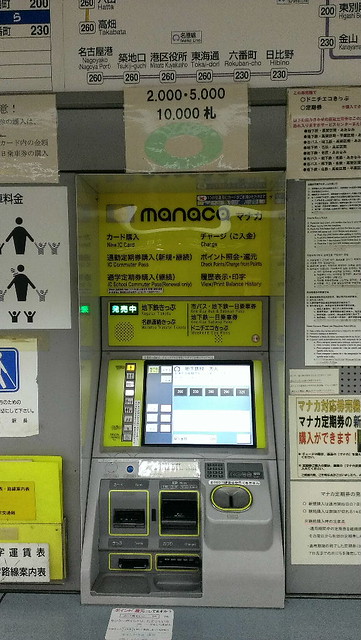
Nagoya is the start and also the end.
We're lucky that the rainy days have passed as we travelled northwards.
Going back to Nagoya from Kanazawa, you have twoi choices.
The first one is the direct train that takes about three hours.
If you want to shorten the time, another way to take the Shinkansen transferred at Maibara JR station.
Because I didn't take the Shinkansen before, I choose the later.
However, I feel quite terrible while transferring.
First, the time for changing the platform is only 10 minutes.
Second, you have to pass another gate to the platform and the tourists are numerous.
So, I feel quite nervous, especially followed by my mon.
In addition, the tickets are three, including the normal train ticket between Kanazawa and Nagoya, the extra fee ticket between Kanazawa and Maibara, and the Shinkansen ticket between Maibara and Nagoya.
You might be confused while you pass the gate.
Which ticket you should feed the machine? The answer is all of the tickets.
The machine is smart to indentify the tickets and it will return the rest tickets belonging to you.
In Taiwan, we always have only ticket for all the transportation.
This different featurre always confuse some of us for the first time.
Arriving at Nagoya station, the first thing is to buy the day pass.
The price is 740 Yen and you could take the subway for most of the atrractions in Nagoya.
I would recommend you to buy the day ticket or store you luggage at the entrance No.11 of Sakura-dori line.
This entrance is close to the west gate of JR station and is also connected to the basement of the department store.
There are lots of coin lockers for use.
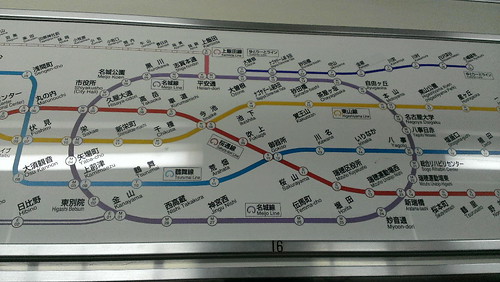
Our first attraction today is Nagoya Castle.
Taking the Sakura-dori line to Hisaya-odori and transferring the Meijo line to Shiyakuso, you will reach Nagoya Castle soon from the subway station.
The Aichi Prefectural Gymnasium is next to the castle.
Many young children are just going out from the swimming pool.
There is a restaurant inside the Gymnasium and we have our lunch there.
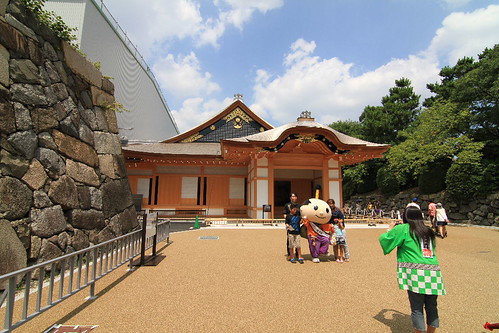
Nagoya Castle was one of the most imprtant castle during the Edo period.
This castle was first built by Imagawa Ujichika and then seized by Oda Nobuhide who changed its name to Nagoya Castle. While Tokugawa Ieyasu emerged victorious, he decide to rebuilt the castle.
Tokugawa Ieyasu is one of the three important and powerful people in Japan. He was the first shogun of the Tokugawa shogunate which rule Japan from 1600 to 1868.
Nagoya Castle has two donjons and the famous feature is the golden Shachihokos (Kinshachi) on the main donjon.
During World War II, Nagoya Castle was destroyed by the bombings of U.S. Army Air Force.
Honmaru Palace, two donjons and the golden Shachihokos were all burned.
In 1959, they reconstructed the donjons and the golden Shachihokos, and the golden Shachihokos became the symbol of Nagoya.
Afterwards, Honmaru Palace is also under reconstrcution by the traditional methods since 2009.
The day we visit nagoya Castle, a part of Honmaru Palace is completed and open to public.

The Honmaru Palace was regards as the finest modern castle architecture in Japan.
Rebuilt in the samurai Shoin architecture style, It doesn't look so antique as it was before.
However, the splendid room with beautiful paintings on the sliding doors is still awesome.
These paintings were painted by masters of the greatest painting school in Japan.
The possibility for rebuilding the former palace is attributed to the old documents, photographs and measured drawings.
It's said the technicians analyzed these materials with the microscope, computers and historical materials so that they could rebuilt the architecture with the same materials and techniques.
The City of Nagoya is currently promoting the restoration of the Hommaru Palace, and raised the fund to collect donations from the public.
With the donation, the entire Honmaru Palace might take back its glory soon.

Behind the Honmaru Palace are the main donjon and minor donjon.
The main donjon was rebuilt to a modern museum with stairs and an elevator.
In the night, the lighted donjon is an obvious part of the night view of Nagoya.
Though this seven-floor architecture looks great from the outside, it has lost its historical value.
You may look at the top of the main donjon. The second generation golden Shachihokos are placed on the roof tilts.
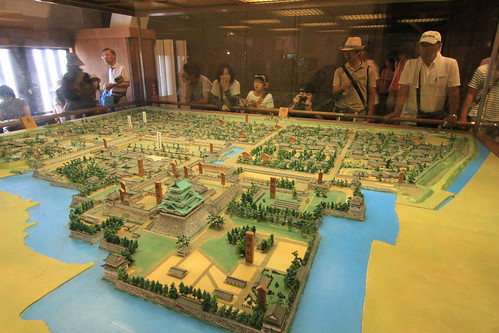
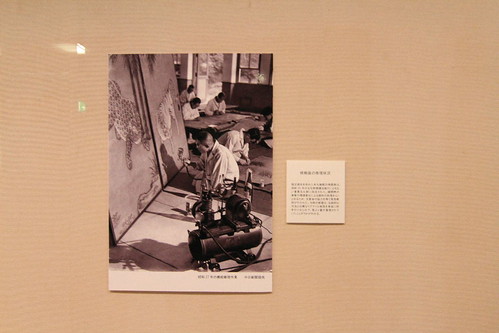
The donjon museum could be accessed by the elevator or the entrance at the minor donjon.
The main exhibitions are displayed from 3rd floor to 5th floor.
You may see the model of Nagoya Castle town in the past, the collections of armors, swords and other stuff.
The recorded photographs show the process of the reconstruction.
Of course, the original antique materials are also visible here.
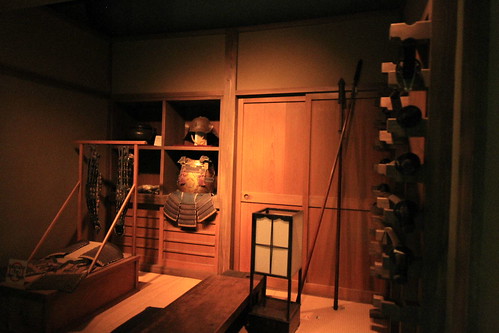
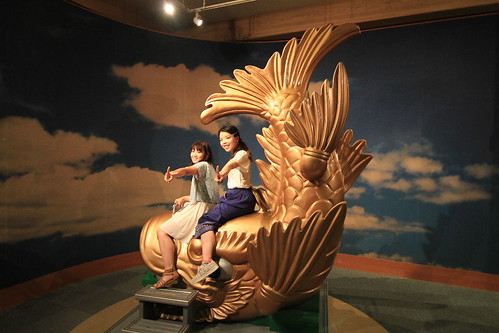
The relica of the town houses might let you image the lifestyle of the people.
Since the golden Shachihoko is a famous feature of Nagoya, the tourists could also take pictures while sitting on the relica.
Going to the top level, the observation deck, you could look around the city scene of Nagoya though the glass windows is the obstacle for photographing.

Taking the subway, the next stop is Osu Kannon Temple.
This temple is a Buddhist temple of the Shingon sect.
Osu Kannon Temple was built in 1333 in Osu-go of Owari Province which is currently the Hashima city in Gifu.
The first head priest, Shōnin Nōshin, dreamed of Avalokitesvara (Kannon, the Buddha of Compassion, 觀世音菩薩 in Chinese) and thus named the temple as Osu Kannon Temple.
In 1612, Osu Kannon Temple was moved to Nagoya by Tokugawa Ieyasu.
By the way, the Japanese Buddhism is a little different from the Chinese Buddhism.
Some of the Japanese Buddhas might not be so popular to Chinese, Taiwan and other Chinese-Buddhism countries.
You may look at the flags allocated along the steps that are written with "南無聖觀世音菩薩".
In fact, most of the Taiwan people only know Avalokitesvara (觀世音菩薩).
So, what is "聖觀世音菩薩"? Is "聖觀世音菩薩" the same as "觀世音菩薩"?
I search for the information and find that there are six Kannons in the Shingon sect:
 Sho Kannon: the Sacred Avalokitesvara (聖觀音)
Sho Kannon: the Sacred Avalokitesvara (聖觀音)
 Juichimen Kannon: the Eleven Faced Avalokitesvara (十一面觀音)
Juichimen Kannon: the Eleven Faced Avalokitesvara (十一面觀音)
 Senju Kannon: the Thousand Armed Avalokitesvara (千手觀音)
Senju Kannon: the Thousand Armed Avalokitesvara (千手觀音)
 Nyoirin Kannon: the Wish Fulfilling Avalokitesvara (如意輪觀音)
Nyoirin Kannon: the Wish Fulfilling Avalokitesvara (如意輪觀音)
 Bato Kannon: the Horse Headed Avalokitesvara (馬頭觀音)
Bato Kannon: the Horse Headed Avalokitesvara (馬頭觀音)
 Juntei Kannon: the Mother Goddess Avalokitesvara (准提觀音)
Juntei Kannon: the Mother Goddess Avalokitesvara (准提觀音)
Therefore, the Sacred Avalokitesvara (聖觀音, 聖觀世音菩薩) is actually one of the Avalokitesvara.
As for the Avalokitesvara in Chinese Buddhism, we know Avalokitesvara could change her/his lookings.
No matter how Avalokitesvara changes, Avalokitesvara is always the same Buddha of mercy and has only one name.
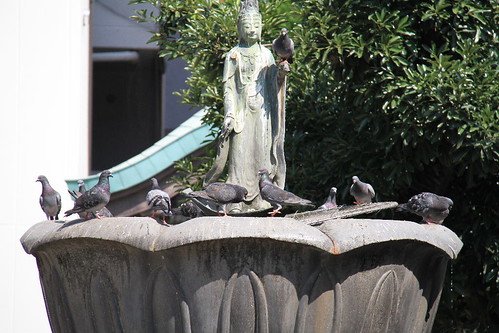
Beside the temple is the entrance to the Osu Shopping Arcade with many shops and restaurants.
If you have plenty of time, these shopping streets may be the place to kill your time.
Except for lots of Buddha staues, there is also another feature of Osu Kannon: the pigeons.
It seems that all the pigeons of Nagoya live in this plaza.
While the tourists feed the toast, you will see numerous pigeons flying together toward the tourists.
Even though this scene is spetacular, I don't recommend to feed these pigeons.
After all, the pigeons are already too many that will cause the environmental problem.

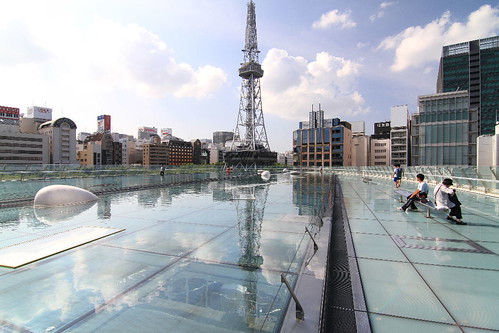
Our last stop today is Nagoya TV Tower and Oasis 21 where is close to our accommodation.
The area, Sakae, is one of Nagoya's main commercial and shopping districts.
It's said that the night scene here is also popular, so that is why we choose the accommodation around Sakae, not Nagoya station.
The Nagoya TV Tower is a 180-meter electric wave tower and also the oldest tower in Japan.
There are two observation decks in different heights though most people might prefer the Sky Promenade at the 42th floor of Midland Square.
As for Oasis 21, it's the shopping mall with a special building that looks like a spaceship.
Before the night, I look around the 4th floor of Oasis 21 to watch the scenes and the reflection of TV tower, and then it's the time for a nice dinner.
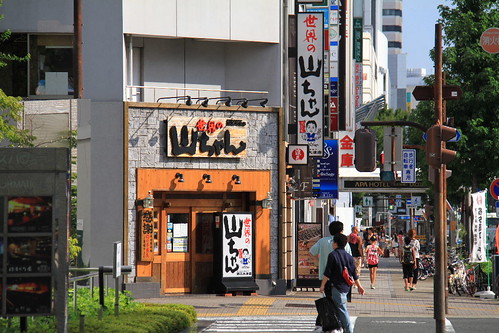
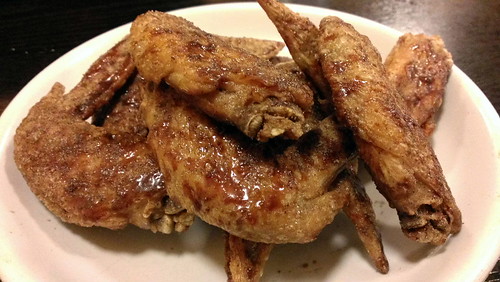
Sekai no Yamachan (世界の山ちゃん) is a famous and popular restaurant in Nagoya.
Sekai no Yamachan has many branches in Nagoya and the product is even sold in the supermarket.
The recommended dish is the fried chicken wing "Maborosi no Tebasaki (幻の手羽先)".
We both agree that this fried chicken wing is the most delicious chicken wing we have tasted.
Except for the chicken wings, I also order the fried Udon with Korean pickled vegetables, the tacoyaki-like fried Gyoza and a drink.
These dishes are basically nice, but the chicken wing is the best.
Although you could buy the seasoning of this chicken wing, I think it's still hard to make the same dish in Taiwan.
How to find the proper chicken wing is a problem, and we don't know the exact cooking procudure.
So, just enjoy your meal in Sekai no Yamachan for the best fried chicken wing.

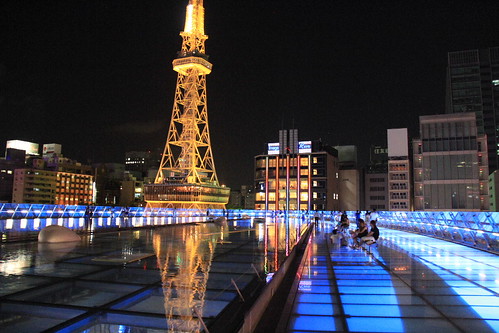
Around seven o'clock, I depart alone to Oasis 21 for the night view.
The tourists on the top floor are much more than the daytime.
If you stand in a good position, you could take a beautiful night view even with the smart phone.
The DSLR with wide-angle lens and CPL filter would be better for a panoramic scene.
So, where is this good position?
It's acutally at the edge of the pool close to the stairs.
You have to get very close to the water surface for a complete reflection of Nagoya TV Tower.
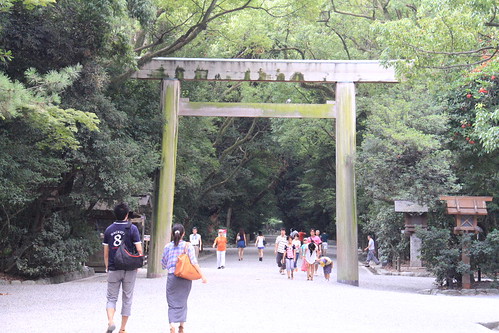
The second day in Nagoya, we are heading for the attractions far from the center of Nagoya city: Atsuta Shrine and Nagoya Harbor.
Atsuta Shrine is one of the greatest centers of the Shrines in Japan, found in 1900.
The enshrined main deity is Amaterasu-Oomikami (天照大神) who is a major deity of the Shinto religion.
In Japanese myth, there were three Imperial Regalia (神器) and one of the Imperial Regalia, the sacred sword Kusanagi-no-tsurugi (草薙の剣), was said to be stored in Atsuta Shrine.
However, someone thought the sacred sword was lost at sea in the Battle of Dan-no-ura. So, the repository of Kusanagi-no-tsurugi in Atsuta Shrine is still unsure.
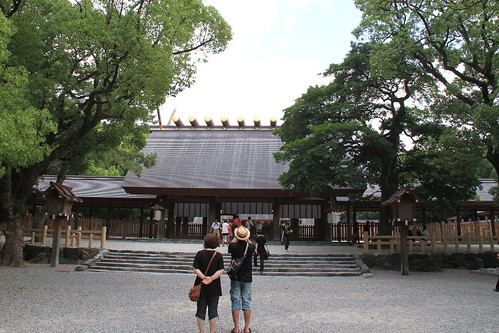
About the Japanese myth, it's the representation of authority and stature of Japan's emperors since time immemorial. Briefly speaking, the Japan's emperor clan are the descendants of the Japnese deity.
For me, I think the sotry of Japanese Myth is very fascinating.
The deities and three Imperial Regalia are widely adpoted as the subject or elements of films, comics and novels.
I stiill could remember an Japanese film that is describing the story of Amaterasu-Oomikami (the goddess of the sun) and his brother Susanoo (the god of sea and storms).
In the story, Susanoo killed the eight-headed serpent, Yamata no Orochi, and found a sword inside the tail of Yamata no Orochi. That is the origin of the secred sword, Kusanagi-no-tsurugi.
No matter where Kusanagi-no-tsurugi is kept in Atsuta Shrine, or it was already lost. Atsuta Shrine is still a place with mystery related to Japanese Myth.
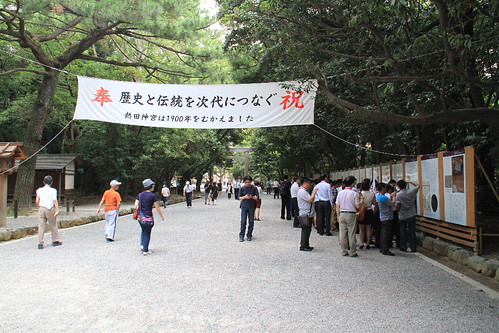
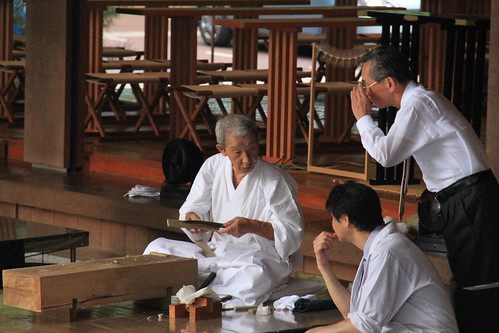
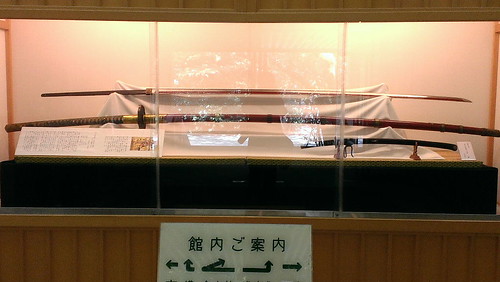
The day we visit Atsuta Shrine, there is also an event called "刀剣研磨技術奉納" (The devotion by showing the grinding technique of swords).
These master forge and grind the words in the plaza to show their techniques as the devotion.
Besides, the Treasure Exhibition Hall (Bunka-Den) also exhibits many Japanese swords.
Entering the front gate, there are two long swords called Otachi (大太刀).
In order to show how long the Otachi is, they place a normal sword as the contract.
One of the Otachi is "Sue no aoe (末之青江)" with the length of 221.5 cm and the weight of 4.5 kg.
According to the information, the original owner Magara Jūrōzaemon was famed for his skill with this Otachi.
Except for the swords, you may also see the hang mirrors, the Bugaku masks and the ancient doucments and articles that are all designated as inportant cultural assets.
Why the swords were contributed to Atsuta Shirne?
It thanks to the secred swords, Kusanagi-no-tsurugi, in the legend.

Looking around Atsuta Shirne, I think it's hard to find the legendary sword.
However, I find an interesting Dogu in a corner.
The stele that the Dogu is located on is named "眼鏡之碑 (The Stele of Glasses)".
This stele was set by the Nagoya Glasses Business Association on the 60th anniversary.
You might wonder why the Dogu is related to glassess?
I'm also confused for the reason, but I guess that is because the Dogu looks like wearing the glassess.
This reason may be too ridiculous, I know.
About the Dogu, it (the real Dogu) was made during the late Jōmon period of prehistoric Japan.
These figurines may be humanoid or animal.
The humanoid Dogu has a funny face and should be the most popular item that you might find in Japanese films or cartoons.
Humanoid Dogu have different lookings but are all female according to the bodies.
On the head, that should be the crown that probably indicates she should be very noble.
If you are interested in the prehistoric culture, you could look for the infromation about Jomon period and its culture.
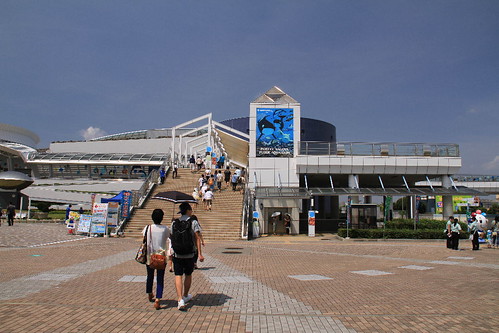
After Atsuta Shirne, our next attraction is Nagoya Harbor where includes an Aquarium, an amusement park and a museum with the observatory.
This place is also a popular attraction in Nagoya.
Among these four spots, we decide to visit the Nagoya Port Aquarium first.
You could buy the common ticket for four attractions with the price of 2400 Yen.


The north building mainly consists of huge tanks that includes one of the largest tanks in the world about 60 meters high.
Through the crystal-clear glass, you could see dolphins (イルカ), killer whales (シャチ), white whales (ベルーガ) and seals.
On the top floor is the outdoor pool where the dolphin performance is held three or four times per day.
Besides, there are also the training and feeding of killer whales and white whales.
The time we visit is just near the schedule time for the dolphin perfermance.
Although there is still 30 minutes before starting the show, the stand is already full of tourists.
If you want to seat in the area close to the pool, remember to wear the raincoat and bring an umbrella.
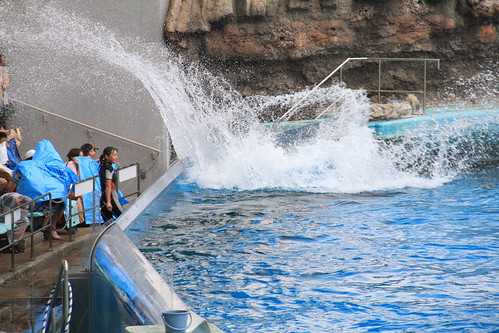
In Taiwan, the Hualien Farglory Ocean Park also has the dolphin show, but I've never been there before.
So, this is my first time to watch the dolphin performance.
I think this is why Nagoya Port Aquarium is so popular because the show is very interesting.
These dolphins could dp many actions, such as splashing the water to the audience, jumping to hit the ball, rolling the hula hoop and etc.


For me, the most special one should be the trainers swimming with the dolphins.
It looks like the trainer and the dolphin become the one.
They are sure to have a great understadning with each other.
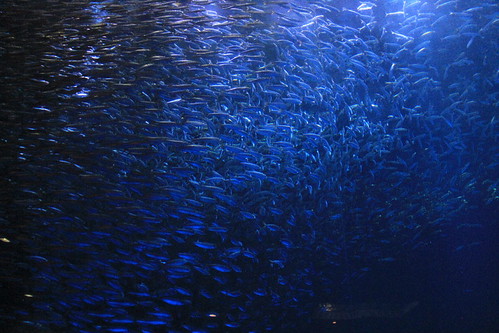
Continuing to the south building, the exhibitions are set with the motif of the voyage the Antarctic research vessel "Fuji" has sailed, including Japan sea, deep ocean, the equatorial sea, the sea of Australia and Antarctic ocean.
Among these maritime creatures, I like the eddy (or tornado) of numerous sardines.
This scene looks very beautiful while you also see the big tunas.
The sea turtles or the biggest crab is still fine, but I'm not so surprised for we also have a very nice Aquarium in Pingtong, Taiwan.
I think our Aquarium has more maritime creatures, though the features of these two aquariums are not the same mostly.
By the way, the official website offers the detailed introductions about the creatures in this aquarium.
You don't have to search for the unforgetable creature that you don't know the name.

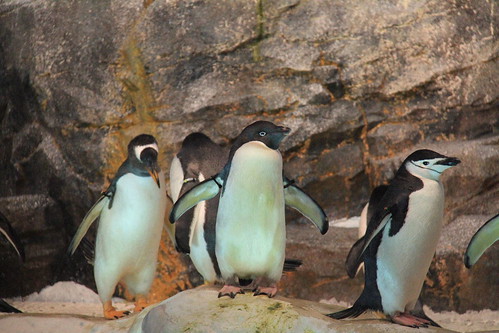
The final part of the south building should be the most popular one: the peguin zone.
There are mainly three kinds of penguins: Gentoo penguin, Adelie penguin and Chinstrap penguin.
Although these penguions are all small, they have different face.
The feeding time is always the most crowded moment.
It's hard to get a good position for photographing.
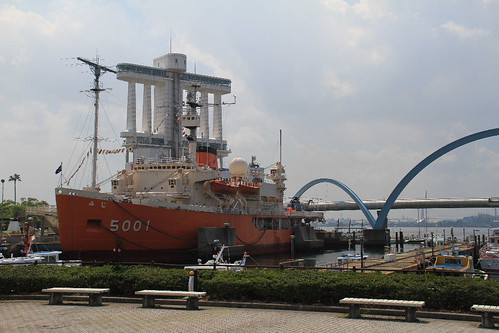
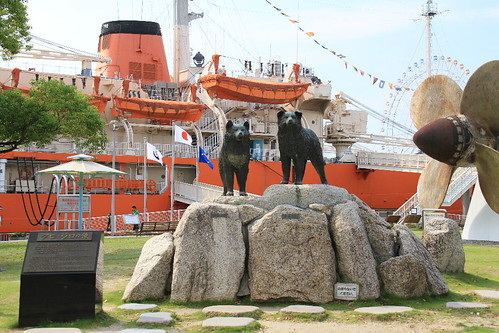
Leaving the auqrium, we go toward the retired Antarctic survey ship "Fuji" that is the museim of Antarctica nowsdays.
If you have watched the Japanese drama "南極大陸 (Nankyoku Tairiku)", I think you should be very excited to see this ship.
In the park nearby, there are the statue of two Sakhalin Huskys (樺太犬), Taro and Jiro, that was left during the second winter survey but survived in Antarctica for one year when they were found at the third survey.
That is the true event and also a miracle, though it also caused the disputation of the ecological impact of Antarctica.
After the disputation, dogs and other live animals are forbidden in Antarctica.
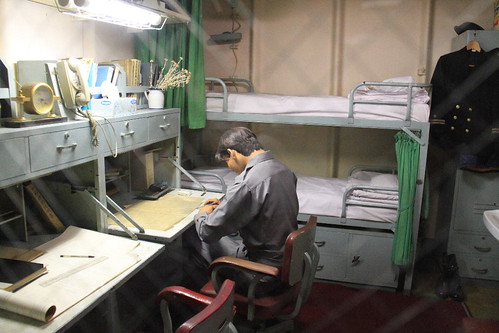
Aboarding the ship, the interior is maintained as its original status, such as the restaurant, the beauty room, the surgery, and the rooms for the officers and the crew.
These rooms are decorated with models and the related stuff to showcase the lifestyle on the voyage towards Antarctica.
I think the only thing we could not experience here is the huge wave in the largest ocean current, the West Wind Drift.
According to the blogs of the tourists who had the voyage toward Antarctica, the West Wind Drift is a terrible difficulty you have to overcome before reaching Antarctica.
It's said that everyone, except the crew, vomited for a few days.


The final attraction in Nagoya Harbor is the Nagoya Port Hall with the Nagoya Ocean Museum and the Observatory.
At the 3rd floor is the ocean museum where you could study the history and development of Nagoya Harbor.
This port is the largest exporter of cars in Japan.
I think everyone who could drive should know the famous Japanese car, Toyota. That is also a popular car in Taiwan.
Going to the top floor, the observatory, you could watch the surrounding of Nagoya Harbor, including the bridge, the ship, the aquarium and amusement park.
From this location, you could see numerous audiences in the outdoor stand. It's quite impressive.


The third day in Nagoya is also our departure day back to Taiwan.
Before going to the airport, we look around the department store nearby the Nagoya JR station.
If there is something I will miss when I'm back, it should be the delicious food in Japan.
I buy the Nigiri-sushi, the eel sushi and the Miso pork stick in the supermarket.
Well, it's not the breakfast and also not the lunch.
Anyway, I just want to enjoy the delicious food as many as I could.
Afterwards, we have the hamburger steak lunch in the restaurant.
Sometimes, we might think that the hamburger is not so delicous as the original beef steak.
However, in Japan, the hamburger steak is out of your expected level and is very tasty.
The portion is big but the price is not expensive.
I think the quality should be better than any steak houses in Taiwan.
Besides, the sweets is also nice, including the Macha-flavor mousse and the pomelo-flavor ice cream.
I quite recommend this hamburger steak house that is located in the 13th floor of the department store.
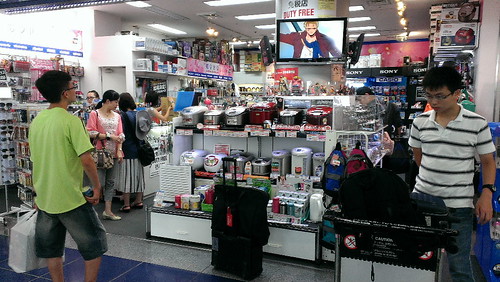
Finally, the 17-day journey is reaching its end.
I saw many beautiful scenes and also enjoy many delicious Japanese cuisines.
For me, it's not a long journey but is surely a memorable trip.
The mountainous area is my favorite, such as Norikura and Tateyama.
Though the weather is hot in the daytime, it becomes cool in the night to let me have the good sleep.
I think visiting Shirakawa-go and Kanazawa in the winter is surely on my waiting list.
But I'm sure of it, because I still have lots of destinations I want to travel to.
~ Fin ~
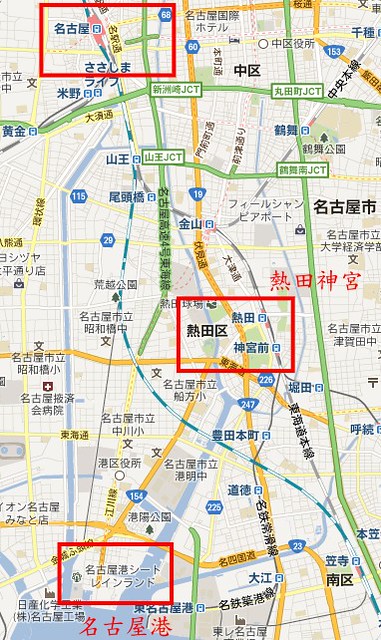
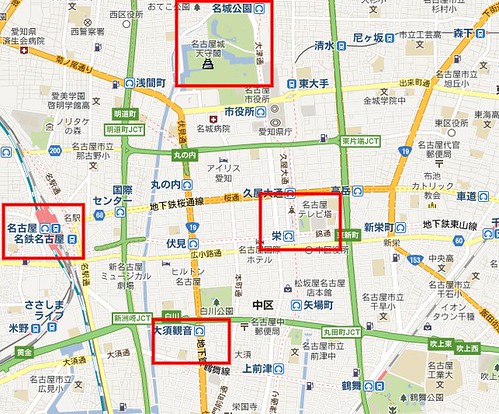
References:
http://en.wikipedia.org/wiki/Nagoya_Castle
http://en.wikipedia.org/wiki/Nagoya_TV_Tower
http://www.atsutajingu.or.jp/jingu/
http://en.wikipedia.org/wiki/Atsuta_Shrine
http://en.wikipedia.org/wiki/Sakae,_Nagoya
http://en.wikipedia.org/wiki/Nagoya_Port
http://en.wikipedia.org/wiki/Port_of_Nagoya_Public_Aquarium
http://en.wikipedia.org/wiki/Tokugawa_Ieyasu
http://en.wikipedia.org/wiki/Shachihoko
http://en.wikipedia.org/wiki/%C5%8Csu_Kannon
http://www.japan-guide.com/e/e3306.html
http://www.nagoya-info.jp/en/eat/tebasaki/post_45.html
http://www.wattention.com/archives/sekai-no-yama-chan/
http://en.wikipedia.org/wiki/Avalokite%C5%9Bvara
http://www.shingon.org/deities/jusanbutsu/kannon.html
http://en.wikipedia.org/wiki/Japanese_mythology
http://en.wikipedia.org/wiki/Amaterasu
http://en.wikipedia.org/wiki/Susanoo
http://en.wikipedia.org/wiki/Tsukuyomi
http://en.wikipedia.org/wiki/Imperial_Regalia_of_Japan
http://en.wikipedia.org/wiki/Yamata_no_Orochi
http://en.wikipedia.org/wiki/Kusanagi
http://en.wikipedia.org/wiki/Battle_of_Dan-no-ura
http://en.wikipedia.org/wiki/Yamato_Takeru
http://en.wikipedia.org/wiki/Onmyoji_(film)
http://en.wikipedia.org/wiki/Tachi
http://en.wikipedia.org/wiki/Nodachi
http://en.wikipedia.org/wiki/Makara_Naotaka
http://en.wikipedia.org/wiki/Dog%C5%AB
http://en.wikipedia.org/wiki/J%C5%8Dmon_period
http://en.wikipedia.org/wiki/Gentoo_Penguin
http://en.wikipedia.org/wiki/Ad%C3%A9lie_Penguin
http://en.wikipedia.org/wiki/Chinstrap_Penguin
http://www.tbs.co.jp/nankyokutairiku/
http://wiki.d-addicts.com/Nankyoku_Tairiku
http://en.wikipedia.org/wiki/Sakhalin_Husky
http://zh-hant.japantourist.jp/view/fuji-the-floating-antarctic-museum


 留言列表
留言列表
